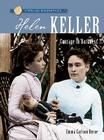Your story about the 2nd-grader exhilarated to stay up reading far past his bedtime hits home here. It's mid-winter break in New York, which means that first Eleanor, and now also Isabel, have successfully petitioned to be allowed to stay up reading with flashlights in their beds every night. ("It's not a school night!") Graphic novels provide Isabel with the ability to read her own chapter-length books, which she stashes under her pillow. Eleanor has a few chapter books going at once -- she's just started the Noel Streatfeild Shoes books -- and is dipping in and out of our growing pile of graphic novels as well. They've been going to bed very happily.

 Last Friday, Eleanor came home with an assignment from her first-grade teacher: to find reading materials at her level in order to research and write a brief biography of a famous American. From a small pool of candidates, Eleanor chose Helen Keller. I immediately put Who Was Helen Keller? on our library hold list -- we love the Who Was... series -- and then emailed you. On your recommendation, I added the Sterling Biography Helen Keller: Courage in the Dark.
Last Friday, Eleanor came home with an assignment from her first-grade teacher: to find reading materials at her level in order to research and write a brief biography of a famous American. From a small pool of candidates, Eleanor chose Helen Keller. I immediately put Who Was Helen Keller? on our library hold list -- we love the Who Was... series -- and then emailed you. On your recommendation, I added the Sterling Biography Helen Keller: Courage in the Dark.Then, yesterday, we went to Books of Wonder, one of my favorite children's bookstores of all time. Their stock is huge, their shelving is brilliant, and they have a big open carpeted space in the back for events, read-alouds, stroller parking, and just plain sitting on the floor and reading. Will napped in his stroller, bless him, and Eleanor and Isabel each picked out a stack of books and got busy.
Annie Sullivan and the Trials of Helen Keller, by Joseph Lambert.
That's right. A graphic novel. About Helen Keller. Clearly, it was fate.
We bought it, of course, and Eleanor took it to bed with her last night. While it turns out to be more about Annie Sullivan's life and character than Helen Keller's, it's an extraordinary book. Lambert uses the power of the graphic novel form to illustrate Helen's initial wordless existence, and then to show her dawning awareness of language. The book begins in Helen's point of view:
The more traditional narrative on the following pages reveals this to be a scene from six-year-old Helen's first "lesson" with Annie Sullivan: to eat, you must sit in a chair and use a spoon.
Lambert tells the story of the early years of Sullivan's time with the Keller family through narrative panels with dialogue, overlaid with Annie's cursive writing describing her challenges and Helen's progress (much of this in Sullivan's actual words, from letters she wrote back to Mr. Anagnos, the head of the Perkins Institution for the Blind, where she was educated). There are also flashbacks to Annie's childhood: suffering in a criminally badly run almshouse, where her brother died of tuberculosis; moving to the Perkins Institution, where she had trouble controlling her temper and fitting in, but rose to the top of her class. There's some difficult material here, especially the death of Annie's brother. Panels from Helen's point of view are woven throughout the book. The famous scene at the water pump, where Helen first makes the connection that the finger-spelled words have a meaning, brought me to tears. Here is Helen's knowledge exploding just afterwards:
Lambert chooses to focus the final third of the book on a plagiarism controversy. At age 10, Helen wrote a story, "The Frost King," which turned out to have the same plot and structure as a published story, "The Frost Fairies." She was accused of plagiarism, and Annie Sullivan came under suspicion by a number of people, including Mr. Anagnos, who had previously supported her through a great number of small offenses. The story ends with Helen and Annie leaving the Perkins school, where they had been living essentially as poster children of the Institution, and going back to the Keller home in Alabama.
Loneliness -- both Helen's and Annie's -- is a primary theme in this book. It gave me a far better sense of Annie Sullivan than I'd had before. Eleanor loved it, but was confused when reading on her own by the plagiarism story, and had trouble deciphering the cursive writing of Annie's letters to Mr. Anagnos. (I think it's aimed more at middle grade audiences, or even older.) Happily, I think this will lead to us having more of a conversation about these issues, and more time reading together.
Love, Annie







I passed this along to a friend of mine who teaches a course on Graphic Novels for high school students. Speaking of high school, I played Annie Sullivan in a high school production of The Miracle Worker in, dare I say it, 1990.
ReplyDeleteRegardless, I am moved by the powerful silence of the snapshots from the GN on Helen Keller and Annie Sullivan. I think my daughter would love them, and I cannot wait to buy this one. I think that 22 months old might not be too early to start reading GN at night.
Love,
Ann
(Old Chum of Annie's from grad school, high school teacher, mom)